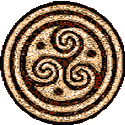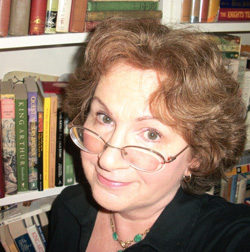Bio
Frequently Asked Quesions
Q: How you come to write about Lady Macbeth?
I have an academic background in medieval studies and a longstanding fascination with medieval history and a particular interest in Scottish history. While researching Celtic Scotland for another writing project, I came across some fairly new scholarly information and conclusions regarding the historical Macbeth and his queen. By all indications, these two monarchs were historically very different, even radically so, from the Macbeth and Lady Macbeth familiar to us from Shakespeare's play.
King Macbeth and Queen Gruoch (who I have called Gruadh) were the strong young monarchs of a Celtic warrior society. Tough but fair-minded, they were respected by their contemporaries, and their long reign—seventeen years, a very long time when compared to most Celtic kings—was relatively peaceful and prosperous, enduring from 1040 to 1057. This was not the Macbeth and Lady Macbeth that most of us knew, and I became insatiably curious to know more.
I was aware of previous fictional treatments of Macbeth by Dorothy Dunnett (KING HEREAFTER, Vintage/Knopf, 1982) and Nigel Tranter (MACBETH THE KING, Hodder & Stoughton, UK, 1978), and others. Yet the newest information and research regarding Macbeth (historical research from about the 1990s), had not been treated in fiction, to my knowledge. As I researched the subject in depth, I began to draw original conclusions of my own. I every detail discussed with some historians, including Dr. Benjamin Hudson, one of the leading academic Celtic historians.
Throughout the process, I’ve tried to respect the historical evidence and to be careful and logical with my conclusions, all of which are based on either history or just plain common sense. Hopefully the novel offers a fresh and unique perspective of the real Lady Macbeth. I’ve done my best to interweave history and fiction in order to present a balanced historical view of this famous, even infamous, royal couple.
Q: How did you research the novel?
Picture me surrounded by stacks of books, whether checked out of libraries, borrowed from historian friends, or bought with my own pennies. Picture me up to my eyebrows in notebooks, papers, and index cards (I often take reading notes on index cards, then divide them up into neat stacks in boxes, a trick I learned in grad school–thus giving myself an outside shot at actually finding that source, quote, or thought someday). Picture my little Westie making herself very comfortable on those stacks of cards and books, and picture them sliding off the sofa or the chair … you get the idea. Research is a long, complicated, layered and sometimes messy prospect.
For the most part, I prefer books to internet research, though the Web certainly comes in handy. Yet turning pages and delving into footnotes is part of the pleasure in the process. Whenever possible, I steered clear of opinionated or devotee sources, and pored over every reliable historical resource I could find; this included primary sources such as the various Irish and British annals, and secondary sources from medieval to modern. I particularly enjoyed and benefited from the work of earlier historians, such as Wyntoun, and much later, W.F. Skene. Not only did I research Macbeth history, but everything to do with the society and time period as well, from Viking ships to costumes, food, trade routes, hunting and hawking, historical medicine, and the Gaelic language.
Eventually I tracked down enough clues and information to build an authentic picture of the real Lady Macbeth and the warrior society in which she lived. I talked with historians and asked endless questions –they were all patient and helpful – because I wanted to be absolutely sure that what I wrote would make historical sense. And I talked with friends, including published authors, to make sure that the novel made sense as a story, too, a construction of plot, character, motivation and emotion.
The several trips I’ve made to Scotland over the years helped enormously when it came time to pull this book together. Though I didn’t set foot in Scotland during the writing of the book, I had been there very shortly before I began the project, so bits of the novel began to form as I visited Dunkeld, the Birnam Wood area, and drove around Perthshire, Fife, and other locations in Scotland. And I spoke often with my Scottish friends, who understand certain aspects of their home and history as only a native can.
Ultimately my intent was to do my very best to produce an entertaining and rich historical novel. If the book adds a little to the vast body of writing surrounding Macbeth and his queen, that’s icing on the oatcake, as it were.
Q: What was the biggest challenge in writing this book?
There were many challenges, some expected, some not. Early on, I asked myself more than once if I was absolutely nuts to take this on. A major hurdle was the amount of extant evidence regarding this woman: one line in a document. Not much to go on!
The historical evidence that a Queen Gruoch, wife of King Macbeth, existed comes from a single land grant written in Latin. Even her name is uncertain and possibly a phonetic rendering of the Gaelic original (see Author’s Note for more information). The clues in that line or two of text are intriguing, and the work of creating Lady Macbeth began there. Most everything that is known or surmised about her life has been extrapolated and pieced together by historians from what is known and accepted of the time in which she lived, and what is known of the events and influential people of her time, including Macbeth, King Malcolm II, Malcolm Canmore, Lulach, and Bodhe, among others.
And of course, there was the looming shadow of Shakespeare to consider. But the further I got into the project, the less intimidated I felt. My own Lady Macbeth was utterly different from the famous villainess; she was a teenager in a warrior society, not a mature woman with fanatical ambitions and more than a touch of craziness. Dorothy Dunnett and Nigel Tranter loomed large as well; their books are stellar and much respected. Again, my own conclusions were so different from theirs that I felt good about writing my novel the way I felt it needed to be done.
As I delved into the research and the plot, as the character of my own Lady Gruadh emerged and evolved, I came to love the story and the characters for themselves. In many ways, my Lady Macbeth had to be created from whole cloth. Though at first it looked like an almost insurmountable task, it turned out to be a good thing.
Q. What was the best thing about writing this particular book?
So many good things have come of this book that it’s hard to identify one thing in particular. I’ve been so fortunate to have met wonderful people who have helped me, and I’m fortunate to have an exacting editor, a supportive agent, several imaginative and patient friends, and a talented, tolerant, loving family. No matter how large or small a book project may be, it’s far easier with helping hands like these.
The research was a lot of fun–though at first it looked ridiculously difficult, I’m like a pig in mud when it comes to deep historical research. I loved every minute of the research, and I have always loved writing. I was lucky to have a great, juicy subject in Lady Macbeth, and lucky to have found a story that came from the heart, from my abiding love of Scots, Celts, medieval, and everything related.
Okay, yes, sometimes the writing was a chore, but often it was pure joy, and that’s how writing often goes, swinging wildly like that. For the most part, the best thing about writing this book was the freedom to explore a subject I found fascinating, and the time and support to create a book I deeply wanted to write.
And another great thing was staying up very late in my jammies while the family slept and the world was quiet…which is without a doubt one of the very nicest privileges of being a writer.


